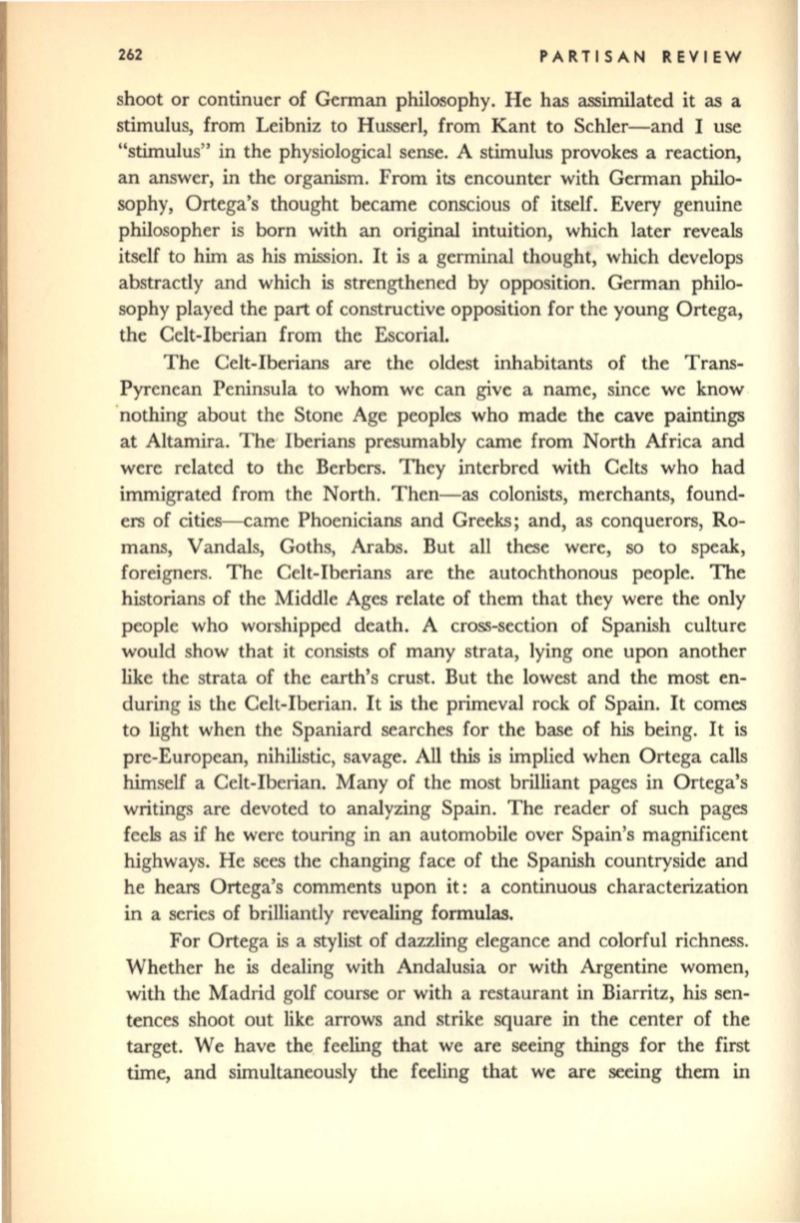
262
PARTISAN REVIEW
shoot or continuer of German philosophy. He has assimilated
it
as a
stimulus, from Leibniz to Husserl, from Kant to SchIer-and I use
"stimulus" in the physiological sense. A stimulus provokes a reaction,
an answer, in the organism. From its encounter with German philo–
sophy, Ortega's thought became conscious of itself. Every genuine
philosopher is born with an original intuition, which later reveals
itself to him as his mission. It is a germinal thought, which develops
abstractly and which is strengthened by opposition. German philo–
sophy played the part of constructive opposition for the young Ortega,
the Celt-Iberian from the Escorial.
The Celt-Iberians are the oldest inhabitants of the Trans–
Pyrenean Peninsula to whom we can give a name, since we know
nothing about the Stone Age peoples who made the cave paintings
at Altamira. The' Iberians presumably came from North Africa and
were related to the Berbers. They interbred with Celts who had
immigrated from the North. Then-as colonists, merchants, found–
ers of cities-came Phoenicians and Greeks; and, as conquerors, Ro–
mans, Vandals, Goths, Arabs. But all these were, so to speak,
foreigners. The Celt-Iberians are the autochthonous people. The
historians of the Middle Ages relate of them that they were the only
people who worshipped death. A cross-section of Spanish culture
would show that it consists of many strata, lying one upon another
like the strata of the earth's crust. But the lowest and the most en–
during is the Celt-Iberian.
It
is the primeval rock of Spain.
It
comes
to light when the Spaniard searches for the base of his being.
It
is
pre-European, nihilistic, savage. All this is implied when Ortega calls
himself a Celt-Iberian. Many of the most brilliant pages in Ortega's
writings are devoted to analyzing Spain. The reader of such pages
feels as if he were touring in an automobile over Spain'S magnificent
highways. He sees the changing face of the Spanish countryside and
he hears Ortega's comments upon it: a continuous characterization
in a series of brilliantly revealing formulas.
For Ortega is a stylist of dazzling elegance and colorful richness.
Whether he is dealing with Andalusia or with Argentine women,
with the Madrid golf course or with a restaurant in Biarritz, his sen–
tences shoot out like arrows and strike square in the center of the
target. We have the feeling that we are seeing things for the first
time, and simultaneously the feeling that we are seeing them in


